Bicycle racks: features, types and choices
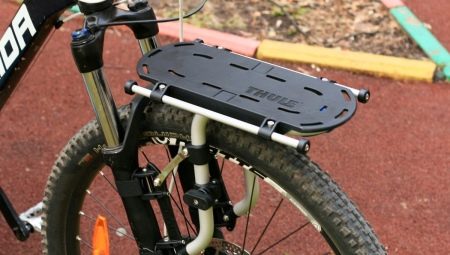
Over time, after purchasing a bicycle, people begin to face the problems of transporting things, because a bicycle is also a transport. The invention that made travel easier for millions - the bike rack. What are there, how to choose the right one and where to fix it? About this and much more in our article.
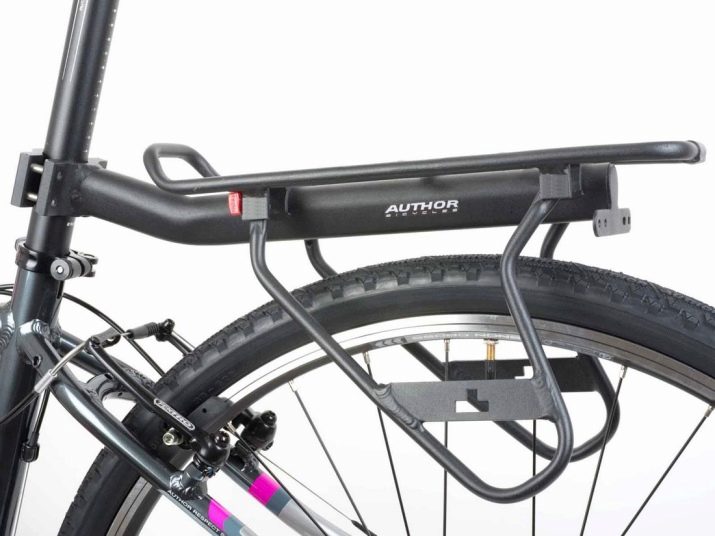
What is it and what is it for?
A bike rack is a metal device that allows you to place and carry cargo on your bike. Often people hang their bags on the handlebars, which makes it much more difficult to control the mechanism, but the bike rack, installed correctly, does not upset the balance when riding. Such a thing is absolutely necessary in cases such as:
- while traveling around the city - often ordinary backpacks may not be very comfortable, strain your back with their weight;
- during the hike - it is possible to install a specialized "bag-pants", which has a large capacity, but leave a lot of space from the trunk itself to secure the rest of the luggage;
- like a seat - to ride your friends and family;
- to install the basket - allows you to transport small pets or other things;
- for installing a child seat - makes it possible to transport small children more safely.
A bicycle rack allows you to transport a much larger amount of weighty and bulky goods when compared with similar transportation on the shoulders or on the handlebars.
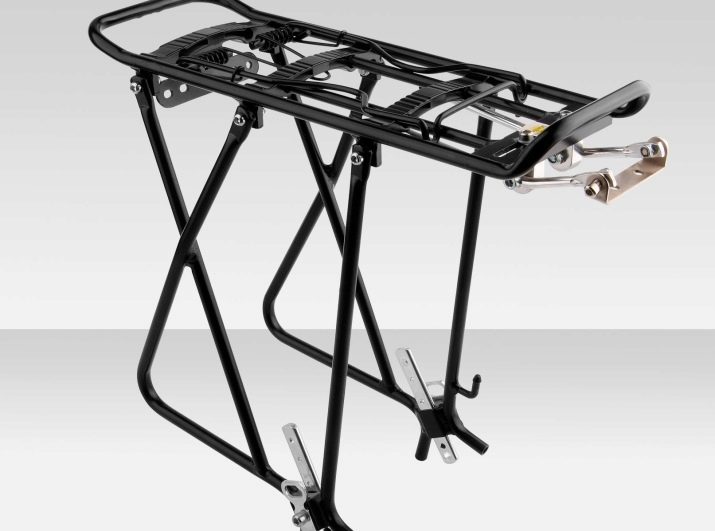
Advantages and disadvantages
The advantages of this device include the following:
- good for your health - reducing the load on the back, on which heavy backpacks were previously transported; sooner or later, improper posture affects the body with pain in the hips, knees and ankle joints, and when using a bike rack, these effects can be leveled;
- comfortable - often during other types of transportation, bags can touch the wheels, get stuck in them, break or disable the wheel, which can lead to an accident; the trunk allows you to avoid such situations;
- comfortable for the body - in the summer, under the backpacks, the back often sweats, which causes some discomfort, because at the destination it will have to be removed; there is a bike rack - no problem.
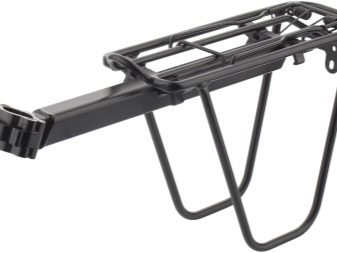
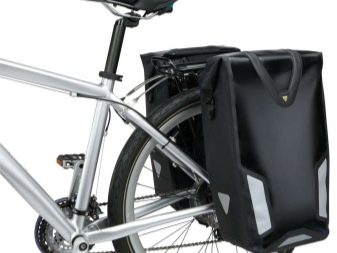
Among the disadvantages of this method of transportation, the following should be noted:
- increase in the mass of the structure - the bike rack has a certain weight, depending on the type of metal from which the trunk is made;
- increasing the load on the rear of the bike - when transporting extremely heavy loads, the rear wheel becomes more susceptible to deformation;
- lack of possibility of fixing with brackets on the frame - some configurations do not provide for holes for the trunk, but this drawback can be eliminated by choosing a console model.
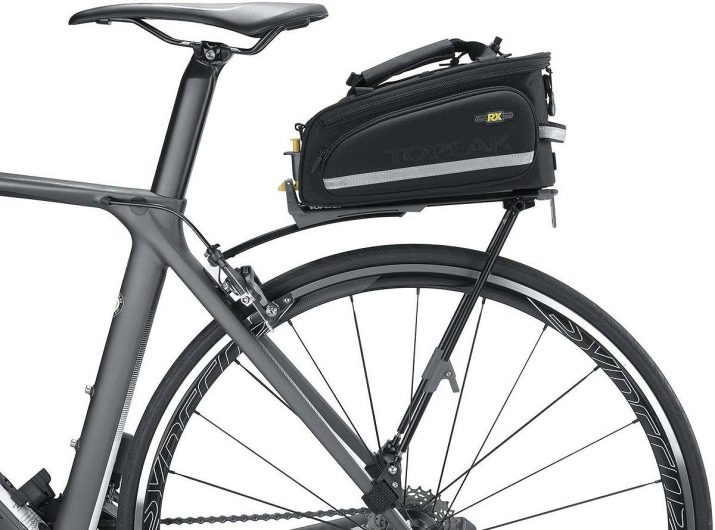
Types of structures and fastenings
When choosing a bicycle rack, you should clarify and take into account such points as:
- rim or disc type of brake system;
- the presence of grooves for fixing the device;
- it is necessary to assume what the degree of load on the structure can be, whether it does not exceed the maximum allowable for this type;
- weight and reliability of the installed structure;
- spaciousness;
- reliability of securing cargo and luggage rack on the bicycle frame;
- the trunk is one-piece or it is possible to assemble and disassemble it;
- check if the bike bag falls into the wheel.

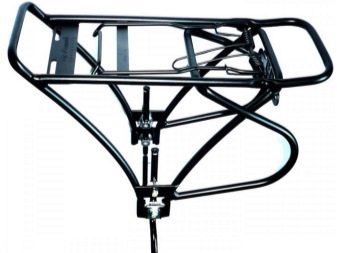
Bicycle carriers are presented in several types.
- Classic or rear rack. It is the most versatile, most common, reliable and inexpensive type of bike rack. For attaching, small bolts are provided that fix the fixture to the rear tube of the frame and to the stays of the rear triangle of the frame. It is characterized by high stabilization during movement, which allows you to transport things without hindrance and do not worry that they will fall over in any direction. Perfect for a long hike in combination with the front or alone, installing a child seat, for attaching a special backpack-trunk (bag-pants). They can be all-welded and collapsible. The first ones are a frame structure and have great strength and reliability.
Dismountable is a set of several bolted parts that can loosen over time, causing luggage to malfunction or fall.
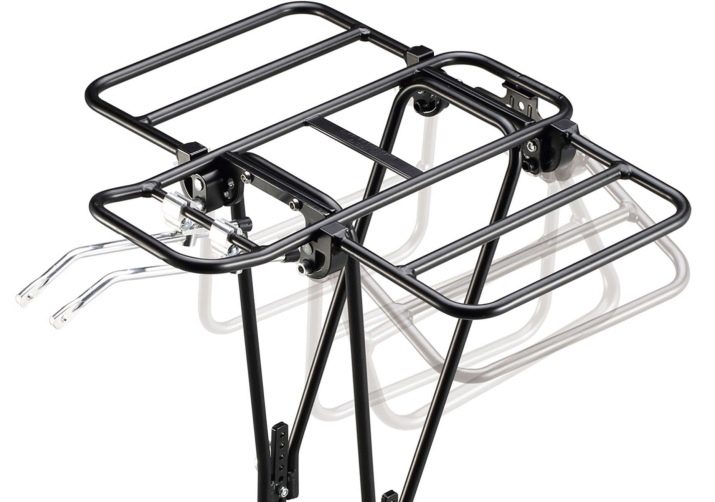
- Front rack or basket... This model is used more often for walking around the city to transport small loads or pets. The regular front rack can be used in conjunction with the rear rack for longer trips. It attaches to the front tube of the bike. It is not recommended to load with large items, as they can block your view and make it difficult to control.

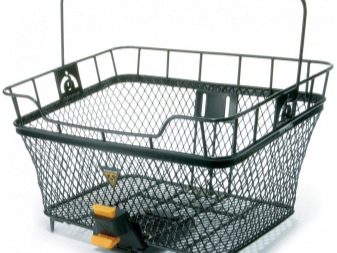
- Console or quick release rack... The easiest view to install, since it is attached only at one point (on the seatpost) and has no other support points. It is not suitable for transporting heavy loads, it does not have a protective pin against the ingress of contents into the spokes of the wheel. Most often, such trunks are used for walking around the city or short-term tourist trips. Disc braking makes it difficult to mount the structure on the bike.
The problem is that the rack mounts interfere with the brake path. This is solved by stopping the selection on the console model. Conventional racks for a disc braking system are fixed with clamps with elastic bands to the upper frame stays.
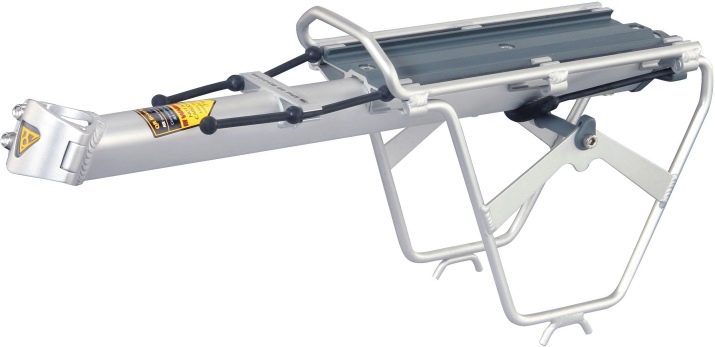
There are the following types of designs:
- single column - most often steel, not very strong and stable, loosening while riding, therefore, not suitable for long-term hikes;
- two-post - can be steel or aluminum, the vertical rack serves as a support, and the other - to protect the load from the wheels;
- tricycle - the safest and most comfortable, maybe classic, V-shaped and Tranz-X.

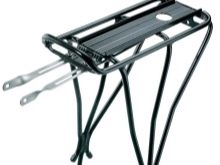
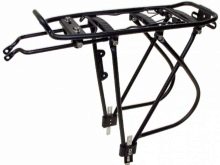
Permissible lifting capacity
For a classic bicycle rack, a load is provided in the range of 20-25 kg, but you should not exceed this threshold, otherwise the bolts and holes for the mounts simply will not withstand. The front rack can carry a load of 5–7 kg. The basket can hold more, but an increase in the load on the front of the bike entails a deterioration in its maneuverability, it becomes many times more difficult to drive it, and for inexperienced users it can even lead to an accident.
It is recommended to distribute them between the front and rear racks 1: 3 before a long trip with a lot of things.
For a quick-release rack, the permissible weight of the transported load is up to 10-15 kg, but it should be taken into account that the entire load from the things and body weight of the seated person falls on the tube under the saddle and the frame structure, so you should not overload the bike rack to the maximum figures.
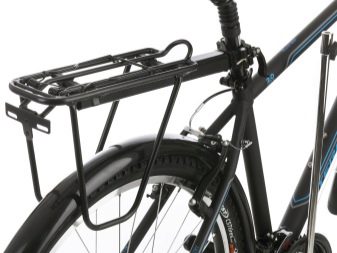
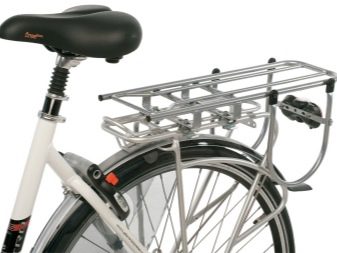
Manufacturing materials
Bicycle racks use metals such as aluminum, titanium and steel. There is no indisputable advantage for any type of material.
Steel trunk:
- pros: very durable, low price, easily repaired with a welding machine, availability;
- minuses: weight (about 1 kg), susceptibility to corrosion.
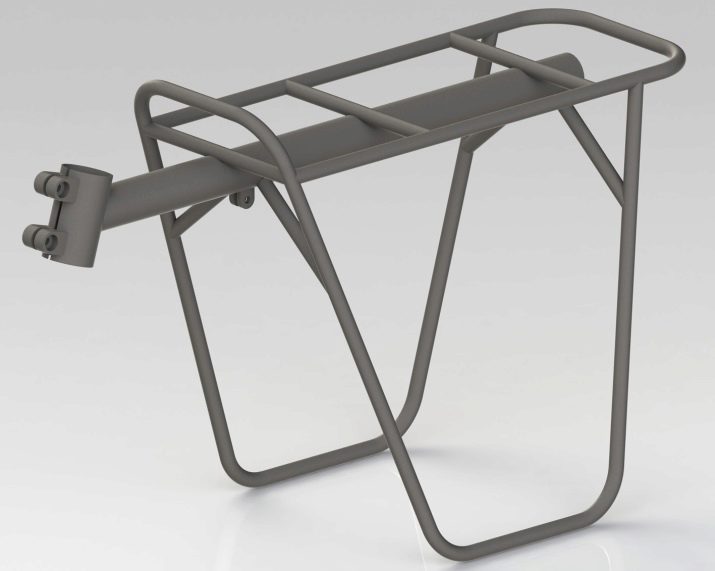
Aluminum trunk:
- pros: light weight (500 g), average cost, versatility, does not corrode;
- minuses: more expensive and more difficult to repair, in comparison with steel.
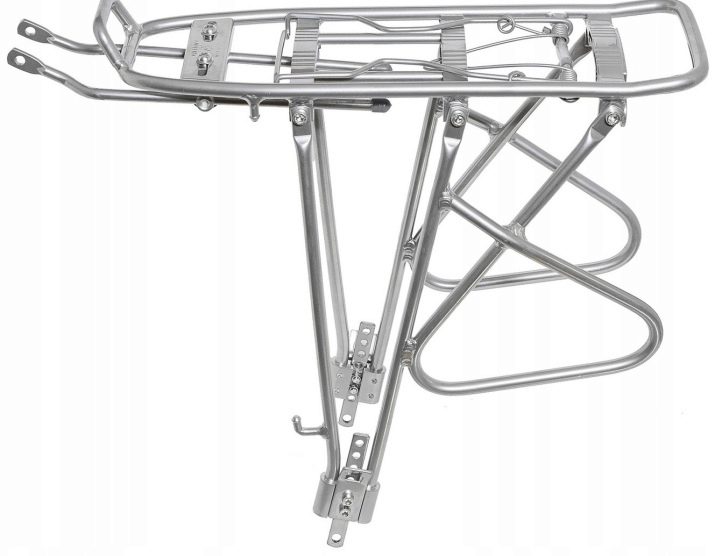
Titanium trunk:
- pros: light weight (500 g), strength, has no tendency to corrosion;
- minuses: more expensive than steel and aluminum, often unavailable for purchase in a store, poor maintainability.
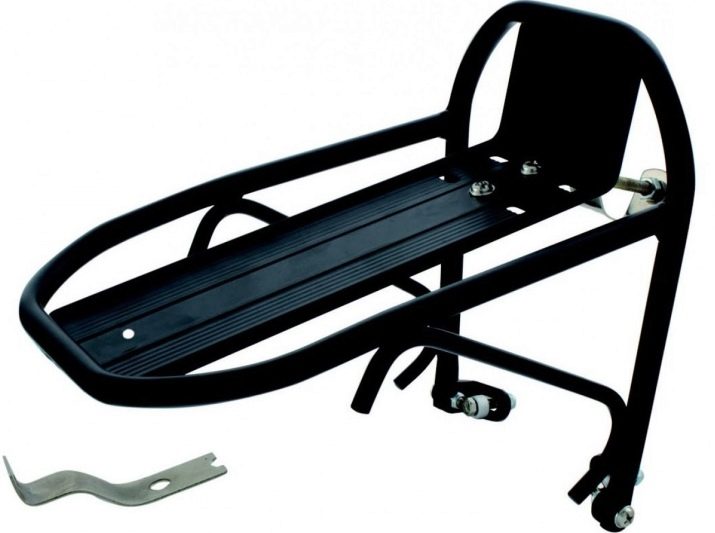
The most common choice is a steel roof rack. With a long journey, it is possible for a little money to fix its breakdown at the nearest service station.
Popular manufacturers
At the moment, companies such as Stels, Topeak and Ibera. Let's take a quick look at several models from these manufacturers.
Stels
Model Stels NH-CS515AA-X quick release, attaches to bike seatpost with dual shock system, fits 24-28 ”wheels, made of black aluminum. Of the minuses, it can be distinguished that the model is more expensive than similar designs.
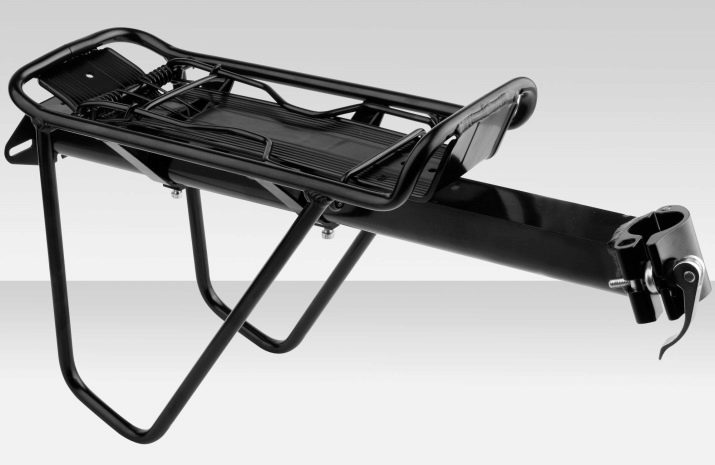
Model Stels BLF-H18 / 010052 is a cheaper version of black and gray color. It can be freely used on all types of bicycles with 20-28 "wheels. There are pins-shields for the wheel, reflective plates.
Of the minuses, the biggest is the high probability of deformation.

Topeak
Model Topeak Explorer Tubular Rack specially designed for bicycles with 29 "wheels. It is made of durable aluminum. Retaining bolts are available for the mid-weight rear light (640g).
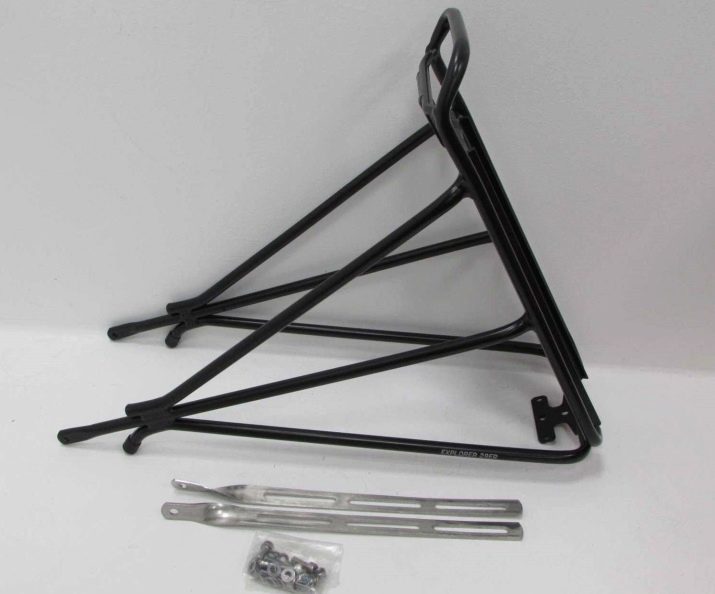
Model Topeak Explorer Tubular Disc Rack (TA2041-B) designed for mountain bikes with 29 "wheels. Installation on a disc brake system is possible. Manufacturing material - aluminum. Minus - more expensive than all the listed analogs.
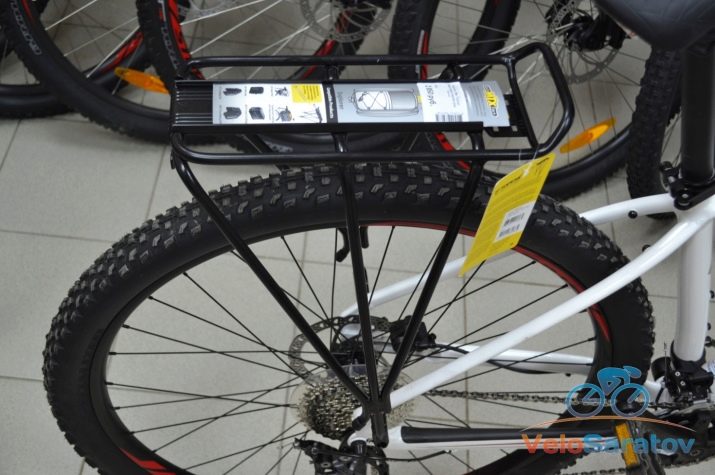
Ibera
Model Ibera IB-RA5 - aluminum rack for bicycles with disc braking system. It has three locking points on the frame, is suitable for 26-28 "wheels, weighs a little over average (770 g), very reliable and durable.
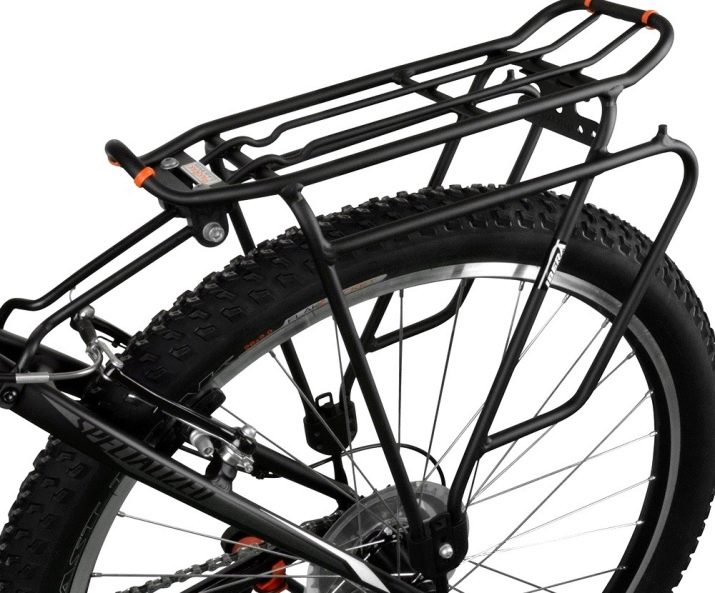
Model Ibera Pakrak Commuter IB-Ra11 designed to carry small items. It attaches to the seat tube and is welded. The set includes elastic bands for securing the load. Of the minuses, it is worth noting rather weighty construction - 880 g.

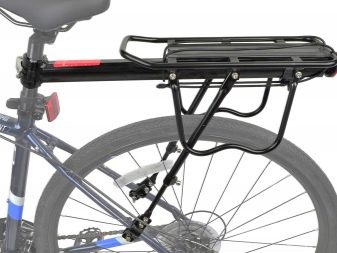
How to choose?
The following tips should be followed to better navigate the selection of your bike rack:
- durable and lightweight material;
- large surface area for securing luggage;
- raised front and rear parts of the platform so that the load does not move perpendicular to the axis;
- the presence of a clamp;
- the ability to adjust the height of the racks;
- the trunk has long fixing pins - "antennae" for fastening to the seatpost;
- a trunk that fits a wide range of wheel sizes (20, 22, 24, 26, 29 inches);
- there is a plate for a reflector, a hook for a road pump;
- one-piece structures do not break longer, and collapsible models can be stored compactly;
- the presence of a pin to protect against luggage getting into the wheel.

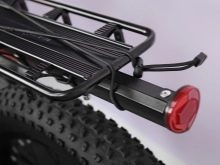

For a mountain bike, the feature is to increase the load capacity by attaching a homemade holder and rim to the seat tube and rear fork legs. For a sports bike, cantilever bags or racks with 4 attachment points on the frame stays are perfect. For touring bikes, opt for a classic spring-loaded rack that fits optimally to bicycles with 26-inch wheels.
The variety of bike rack models can be confusing for an inexperienced bike owner, but applying the new knowledge from this article, you can safely go to the store and enjoy comfortable trips without thinking about where to put your things.
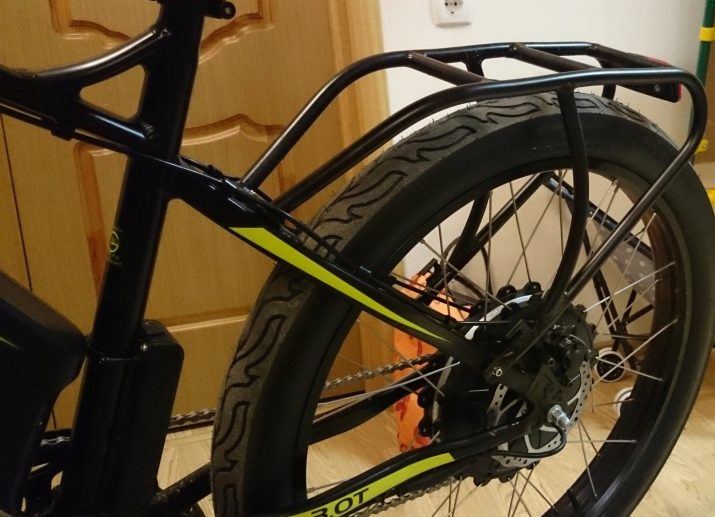
For tips on choosing a bike rack, see below.








